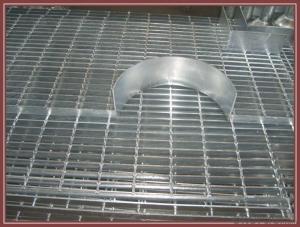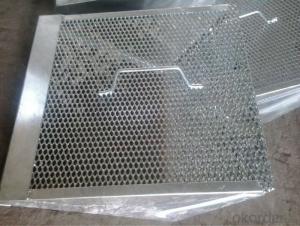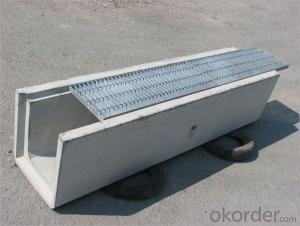Aluminum Bar Flat Welding With Aluminum Rod Bar For Aluminum Grating
- Loading Port:
- Qingdao
- Payment Terms:
- TT OR LC
- Min Order Qty:
- 5000 pc
- Supply Capability:
- 6000000 pc/month
OKorder Service Pledge
OKorder Financial Service
You Might Also Like
1.Description of Drainage trench cover:
Drainage trench cover is widely used in the urban road, the square, the botanical garden, the wharf, the airport, the parking lot, the road, each kind of industry, the civil project, etc.
2.Main features of Drainage trench cover:
I--Carrying 20 tons of weight
II—Carrying 14 tons of weight
III---carrying 6 tons of weight
IV---carrying 2 tons of weight
V---Carrying pedestrian weight
3.Glass Wool Blanket Images:

4. Drainage Trench Cover Technical Parameters:
These drain cover plate applies to the road cross-sectional and longitudinal drain. The drains width ranging from 200mm to 550mm.
A means the steel grating length
H means the steel grating height
A means the frame length
H means the frame height
5.FAQ
We have organized several common questions for our clients,may help you sincerely:
①How about your company?
A world class manufacturer & supplier of Drainage trench cover is
one of the large scale professional investment casting production bases in China,consisting of both casting foundry forging and machining factory. Annually more than 8000 tons Precision casting and forging parts are exported to markets in Europe,America and Japan. OEM casting and forging service available according to customer’s requirement.
②How to guarantee the quality of the products?
We have established the international advanced quality management system every link from raw material to final product we have strict quality test; We resolutely put an end to unqualified products flowing into the market. At the same time, we will provide necessary follow-up service assurance.
- Q:Can aluminum sheets be used for aircraft manufacturing?
- Indeed, aircraft manufacturing commonly utilizes aluminum sheets. This lightweight and corrosion-resistant material proves to be an excellent option for crafting diverse aircraft components. Its strength allows it to endure the pressures and tensions experienced during flight, while its malleability enables it to take on various forms and sizes. Moreover, aluminum sheets can be effortlessly joined together using diverse welding techniques, facilitating efficient and effective assembly of aircraft structures. Consequently, the utilization of aluminum sheets in aircraft manufacturing ensures a harmonious combination of strength, weight, and durability, rendering it a favored material in the aerospace sector.
- Q:What are the different surface treatments available for aluminum sheets?
- Aluminum sheets have several surface treatment options, each with its own unique properties and advantages. Anodizing, painting, powder coating, and laminating are some of the most commonly used methods. Anodizing, a popular technique, involves immersing the aluminum sheet in an electrolyte solution and passing an electric current through it. This creates a protective oxide layer on the surface, enhancing corrosion resistance, durability, and offering decorative finishes in various colors. Painting is another frequently chosen treatment. It involves applying a layer of paint to the sheet, improving aesthetics and providing protection against corrosion and environmental factors. Painting allows for a wide range of colors and finishes, making it versatile for different applications. Powder coating is an electrostatic process where a dry powder is applied to the aluminum sheet and then cured under heat. This creates a durable and attractive finish with excellent resistance to weathering, chemicals, and UV rays. It offers a variety of color options, textures, and finishes suitable for outdoor use. Laminating involves bonding a thin layer of a different material, like plastic or wood, onto the aluminum sheet. This enhances aesthetics and provides additional properties such as scratch resistance, increased strength, and insulation. Laminating offers a wide range of finishes and textures, allowing for customization and design versatility. These examples demonstrate the various surface treatments available for aluminum sheets. The choice of treatment depends on specific application requirements, desired aesthetics, durability, and environmental factors. Seeking guidance from a professional or supplier can assist in determining the most suitable surface treatment option for a particular project or application.
- Q:What are the different types of alloys used for anodized aluminum sheets?
- Anodized aluminum sheets can be made using various types of alloys, each with its own unique characteristics and uses. Some commonly used alloys include: 1. Pure aluminum, found in 1000 series alloys, is highly resistant to corrosion. It is frequently employed in anodized aluminum sheets across different industries such as architecture, automotive, and aerospace. 2. The 5000 series alloys, which contain magnesium as the primary alloying element, offer increased strength and excellent weldability. These alloys are often chosen for anodized aluminum sheets in applications that require high strength and resistance to atmospheric corrosion. 3. The 6000 series alloys are renowned for their exceptional combination of strength, extrudability, and corrosion resistance. Among this series, the 6061 alloy is widely used for anodized aluminum sheets in structural components, marine applications, and consumer electronics. 4. The 7000 series alloys are famous for their extraordinary strength and are typically used in applications that demand high-performance materials. The most commonly utilized alloy in this series for anodized aluminum sheets is 7075, which finds extensive use in the aerospace and defense industries. 5. The 2000 series alloys are mainly employed when high strength and excellent fatigue resistance are needed. These alloys are commonly used in the aerospace industry for anodized aluminum sheets. It is crucial to consider the specific requirements of the application, including desired strength, corrosion resistance, and other mechanical properties, when selecting the appropriate alloy for anodized aluminum sheets.
- Q:Can 101 aluminum sheets be used in aerospace applications?
- Yes, 101 aluminum sheets can be used in aerospace applications. 101 aluminum is a commonly used alloy in the aerospace industry due to its excellent strength-to-weight ratio, high corrosion resistance, and good formability. It is often used for structural components, such as aircraft skins, wings, and fuselage panels. Additionally, 101 aluminum sheets can be easily machined and welded, making them ideal for aerospace applications where precision and durability are crucial.
- Q:Can 101 aluminum sheets be purchased in small quantities or only in bulk?
- Both small quantities and bulk purchases of aluminum sheets are typically available. The availability may vary depending on the supplier or retailer, but many offer aluminum sheets in a range of sizes and quantities to meet the diverse needs of customers. Whether you need a few sheets for a small project or a larger quantity for industrial purposes, it is beneficial to explore different suppliers to find the option that aligns with your requirements.
- Q:What is the maximum temperature resistance of aluminum sheets?
- The maximum temperature resistance of aluminum sheets is typically around 600 degrees Fahrenheit (315 degrees Celsius). However, this can vary depending on various factors such as the alloy composition, thickness, and treatment of the aluminum sheets. It is always important to consult the manufacturer's specifications or obtain professional advice when considering the use of aluminum sheets in high-temperature applications.
- Q:How to mix solid aluminium sheet with solid copper sheet (using heat?) to make a compound.
- I'm not sure if I correctly understand your question - that is, whether you're asking how to physically fasten copper and aluminum pieces together, or of you're asking how to make intermetallic compounds of copper and aluminum. Since you did mention a compound, though, I'm guessing the latter. Copper and aluminum do react to form a number of intermetallic compounds. Among these are Al4Cu9, AlCu, and Al2Cu (see first reference below). These are referred to as aluminides of copper, and may be prepared by melting the two metals together in the proper ratio by weight and cooling slowly. For example, Al2Cu (also called CuAl2) may be prepared by melting a mixture containing 96% aluminum and 4% copper (see second reference below). Note that a protective inert atmosphere is desirable for any work of this sort to prevent oxidation. CORRECTION: The compound CuAl2 contains about 54% copper and 46% aluminum (NOT as above). It's the 2000 series aluminum alloys which contain around 4% copper, and it is the precipitation of CuAl2 during heat treatment which makes them hardenable. The final sentence in the second paragraph above should read: For example, Al2Cu (also called CuAl2) may be prepared by melting a mixture containing 46% aluminum and 54% copper (see second reference below).
- Q:What is the maximum size available for aluminum sheets?
- The maximum size of aluminum sheets can differ based on the manufacturer and specific demands. Nonetheless, aluminum sheets can typically be found in sizes of up to 4 feet by 12 feet (48 inches by 144 inches) or even larger. Industries such as construction, aerospace, and automotive manufacturing often utilize these bigger dimensions. It's worth mentioning that custom sizes can also be created to meet individual project requirements.
- Q:How do I prevent corrosion on aluminum sheets?
- To prevent corrosion on aluminum sheets, there are a few steps you can take: 1. Clean the aluminum sheets regularly: Use a mild detergent or aluminum cleaner to remove any dirt, grime, or chemical residues that may be present on the surface. This will prevent the buildup of corrosive substances. 2. Apply a protective coating: Consider applying a protective coating on the aluminum sheets. There are various types of coatings available, such as clear coats, anodizing, or painting. These coatings act as a barrier between the aluminum and the surrounding environment, preventing corrosion. 3. Avoid contact with corrosive substances: Aluminum can be susceptible to corrosion when it comes into contact with certain chemicals, such as acids, alkalis, or saltwater. Be mindful of the environment in which the aluminum sheets are stored or used and avoid exposure to these corrosive substances. 4. Use proper storage methods: Store aluminum sheets in a dry environment with low humidity levels. Moisture can accelerate the corrosion process, so it's important to keep the sheets dry and protected from excessive moisture. 5. Implement preventive measures: Consider using corrosion inhibitors or anti-corrosion sprays specifically designed for aluminum. These products can provide an extra layer of protection against corrosion, especially in harsh or corrosive environments. By following these preventive measures, you can significantly reduce the risk of corrosion on aluminum sheets and prolong their lifespan.
- Q:If you're familiar with some of my previous questions, you'll know I have a thing for DC-3's, and I'd like to buy one and fix it up at some point in my life. I was looking at pictures on Google for my desktop background and saw several with shiny chrome/aluminum bodies. Well, first of all, is it chrome or polished aluminum? Second, would I be able to buy a DC-3 painted this God-awful forest green and put whatever it is (chrome/aluminum) on said plane? Or is it something that the plane has to be built with originally?
- Polished aluminum... airplanes are not chrome plated... weight and the difficulty of electro-plating an entire aircraft are the reasons Could likely get some dissimilar metal corrsosion problems as well... Polished aluminum airplanes are absolutely beautiful, but it takes an incredible amount of work to get it that way, and a nearly equal amount of work to keep it up... plan on spending lots of time, money or both...
1. Manufacturer Overview |
|
|---|---|
| Location | |
| Year Established | |
| Annual Output Value | |
| Main Markets | |
| Company Certifications | |
2. Manufacturer Certificates |
|
|---|---|
| a) Certification Name | |
| Range | |
| Reference | |
| Validity Period | |
3. Manufacturer Capability |
|
|---|---|
| a)Trade Capacity | |
| Nearest Port | |
| Export Percentage | |
| No.of Employees in Trade Department | |
| Language Spoken: | |
| b)Factory Information | |
| Factory Size: | |
| No. of Production Lines | |
| Contract Manufacturing | |
| Product Price Range | |
Send your message to us
Aluminum Bar Flat Welding With Aluminum Rod Bar For Aluminum Grating
- Loading Port:
- Qingdao
- Payment Terms:
- TT OR LC
- Min Order Qty:
- 5000 pc
- Supply Capability:
- 6000000 pc/month
OKorder Service Pledge
OKorder Financial Service
Similar products
New products
Hot products
Related keywords































